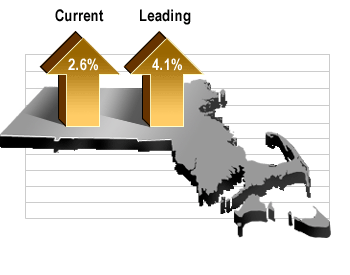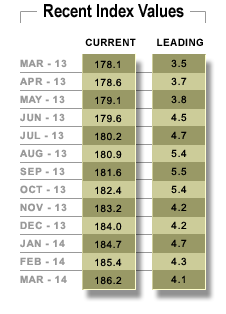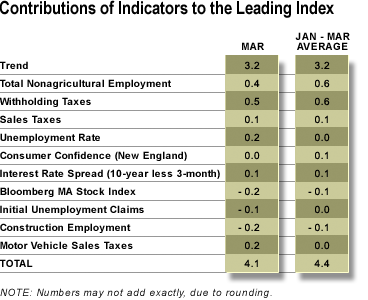Mass Economy Continues its Expansion in Q1 2014, UMass Journal Reports
Growth is fueled by increases in spending, incomes, and international exports.
March 2014
 Massachusetts real gross domestic product grew at an estimated annual rate of 2.6 percent in the first quarter of 2014 according to the MassBenchmarks Current Economic Index, released today by MassBenchmarks, the journal of the Massachusetts economy published by the UMass Donahue Institute in collaboration with the Federal Reserve Bank of Boston. In contrast, according to the U.S. Department of Commerce, national real gross domestic product grew at an annual rate of 0.1 percent, according to the preliminary estimate of the U.S. Bureau of Economic Analysis. In the fourth quarter of last year Massachusetts real GDP grew at a revised 4.4 percent annual rate as compared to a 2.6 percent rate for the U.S.
Massachusetts real gross domestic product grew at an estimated annual rate of 2.6 percent in the first quarter of 2014 according to the MassBenchmarks Current Economic Index, released today by MassBenchmarks, the journal of the Massachusetts economy published by the UMass Donahue Institute in collaboration with the Federal Reserve Bank of Boston. In contrast, according to the U.S. Department of Commerce, national real gross domestic product grew at an annual rate of 0.1 percent, according to the preliminary estimate of the U.S. Bureau of Economic Analysis. In the fourth quarter of last year Massachusetts real GDP grew at a revised 4.4 percent annual rate as compared to a 2.6 percent rate for the U.S.
"The relatively strong growth for Massachusetts in the first quarter reflects a moderate increase in employment, a sharp fall in the unemployment rate, very strong wage and salary income growth, and increased spending by households and businesses," noted Alan Clayton-Matthews, MassBenchmarks Senior Contributing Editor and Associate Professor of Economics and Public Policy at Northeastern University, who compiles and analyzes the Current and Leading Indexes.
During the first quarter of 2014, payroll employment expanded at a 1.2 percent annual rate, wage and salary income — based on state withholding tax collections — increased at a 15.0 percent annual rate, and spending on goods subject to the state regular sales tax and the motor vehicle sales tax grew at a 6.1 percent annual rate. "Wage and salary income growth in the last two quarters have likely been boosted by better-than-average bonuses for workers as a result of the sharp rise in stock markets last year," noted Clayton-Matthews.
 The Massachusetts economy also appears to be benefitting from improving conditions in national and world economies. On an annual average basis, Massachusetts merchandise exports in 2013 were 4.6 percent higher than in 2012, after having fallen 7.7 percent between 2011 and 2012. Nationally, merchandise exports in 2013 were 2.1 percent higher than in 2012. While there are some downside risks to the state's economic outlook associated with slowing growth in China and the uncertainty associated with the crisis in Ukraine, for the time being at least, national and state growth is being supported by the momentum of strengthening domestic demand.
The Massachusetts economy also appears to be benefitting from improving conditions in national and world economies. On an annual average basis, Massachusetts merchandise exports in 2013 were 4.6 percent higher than in 2012, after having fallen 7.7 percent between 2011 and 2012. Nationally, merchandise exports in 2013 were 2.1 percent higher than in 2012. While there are some downside risks to the state's economic outlook associated with slowing growth in China and the uncertainty associated with the crisis in Ukraine, for the time being at least, national and state growth is being supported by the momentum of strengthening domestic demand.
The MassBenchmarks Leading Economic Index for March was 4.1 percent, and the three-month average for January through March was 4.4 percent. The leading index is a forecast of the growth in the current index over the next six months, expressed at an annual rate. Thus, it indicates that the state economy is expected to grow at an annualized rate of 4.1 percent over the next six months (through September 2014).
The 10 indicators that comprise the leading index usually do not all move in tandem. Typically, some may indicate an expectation of faster than average growth, while at the same time others may indicate an expectation of slower than average growth. The table on the left accounts for the contributions of each towards faster or slower growth than the long-term trend of 3.2 percent. The index value is their sum.
 In March, six indicators contributed to a forecast of above-trend growth: total nonagricultural employment, withholding taxes, sales taxes, the unemployment rate, the interest rate spread between 10‑year and 3‑month U.S. Treasury securities, and motor vehicle sales taxes. Three indicators contributed to below-trend growth: the Bloomberg stock index for Massachusetts, initial unemployment claims, and construction employment. One indicator, consumer confidence, contributed to average-trend growth.
In March, six indicators contributed to a forecast of above-trend growth: total nonagricultural employment, withholding taxes, sales taxes, the unemployment rate, the interest rate spread between 10‑year and 3‑month U.S. Treasury securities, and motor vehicle sales taxes. Three indicators contributed to below-trend growth: the Bloomberg stock index for Massachusetts, initial unemployment claims, and construction employment. One indicator, consumer confidence, contributed to average-trend growth.
In the three-month period January through March, five indicators contributed to a forecast of above-trend growth: total nonagricultural employment, withholding taxes, sales taxes, consumer confidence, and the interest rate spread between 10‑year and 3‑month U.S. Treasury securities. Two indicators contributed to below-trend growth: the Bloomberg stock index for Massachusetts, and construction employment. Three indicators contributed to average-trend growth: the unemployment rate, initial unemployment claims, and motor vehicle sales taxes.
The current and historical quarterly estimates for state domestic product growth include adjustments for changes in productivity growth. These adjustments are estimates of the quarterly deviations from trend in the growth of the ratio of output to employment and output to wage and salary income. In the first quarter of 2014, these adjustments subtracted 2.4 percentage points from the annual rate of growth. In the fourth quarter of 2103, these adjustments subtracted 0.8 percentage points from the annual rate of growth. For the forecast of state domestic product growth in the second and third quarters of this year, productivity growth is assumed to return to its long-term trend.
Several recent months of the indices are revised each release. These revisions are a result of the statistical method used to create the index, as well as revisions in the underlying indicators.
--------
All of the indicators except interest rates refer to Massachusetts. The current index is composed of four indicators: nonagricultural employment, withholding taxes, sales taxes, and the unemployment rate. The leading index includes these four current indicators plus the other six (leading) indicators in the contributions table. All of the indicators are as of March, except for interest rates and the Bloomberg stock index for Massachusetts, which are through April 17th. The MassInsight Consumer Confidence Index is released every third month. Intervening months are interpolated, and changes in the Conference Board's Consumer Confidence Index for the U.S. are used to extrapolate to the current month of the index, as needed. Series measured in current dollars or values, i.e., withholding taxes, sales taxes, the Bloomberg stock index, and motor vehicle sales taxes, are deflated by the U.S. consumer price index for all urban consumers, excluding food and energy.
For a description of the methodology used to construct these indices, see: Alan Clayton-Matthews and James H. Stock, "An application of the Stock/Watson index methodology to the Massachusetts economy," Journal of Economic and Social Measurement, vol. 25 (1998/1999), pp. 183-233.
Dr. Alan Clayton-Matthews
MassBenchmarks
Northeastern University, School of Public Policy and Urban Affairs
April 30, 2014

